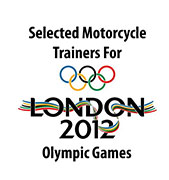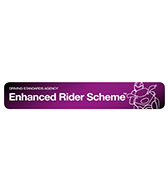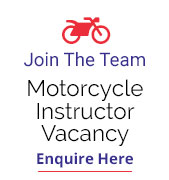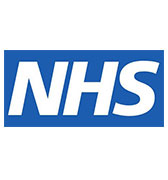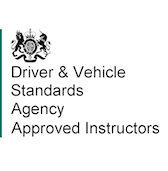CBT - Compulsory Basic Training
CBT is the first course that learner motorcyclists are required to attend. The CBT course generally takes a whole day to complete, and providing a safe and satisfactory standard has been achieved, you will be awarded a DL196 (CBT Certificate) which will allow you to ride on the road unaccompanied for the next 2 years.
The course syllabus is set out and defined by the DVSA (Driver Vehicle Standards Agency), and is currently divided into 5 sections which are referred to as ‘Elements’.
- Element A - Introduction
- Element B - Practical On-Site Training
- Element C - Practical On-Site Riding
- Element D - Practical On-Road Training
- Element E - Practical On-Road Riding
Element A - Introduction
This element begins by your instructor checking your driving licence, whcih you would have been asked to bring along with you. You will then be asked to perform an eyesight check by reading a vehicle registration mark from a distance of 20.5 meters. Next, your instructor will sit you down and go through an introduction and explain the format of the day, and what is involved in the CBT course. Your instructor will then progress to explain the different requirements and recommendations for helmets & clothing when riding a motorcycle or scooter.
Element B - Practical On-Site Training
During this Element, we will explain to you how the controls of your motorcycle/scooter work, and also explain the basic maintenance checks to help ensure that your bike remains safe and road legal. During this element, you will get to be ‘hands on’ with bike under your instructors supervision, familiarising yourself with the controls, as well as learning how to switch on and switch off the engine, and take the bike on and off of its stand.
Element C - Practical On-Site Riding
Element C is the first part of the day most students look forward to the most, as it involves you riding the bike. Your instructor will mark out a ‘safe area’ for you to practice riding your bike in. You will then be asked to perform a series of exercise's including a figure of 8, U-turn, Emergency Stop & Junction simulation tasks to name a few. These exercises must be completed to a satisfactory standard.
Our instructors need to be satisfied that you can control your bike. If you are unable to evidence this in a ‘safe & sterile environment’ then we are unable to progress you to the next Elements, which involve you being in a more hostile environment on the public roads, as mistakes here can lead to catastrophic consequences.
Element D - Practical On-Road Training
Element D is a theory based session about the risks and dangers we can potentially be faced with on the road, and what we can do to make ourselves as safe as possible should we encounter such situations.
Argueably, the most important part of being safe on the road is to ensure you understand the rules of road, as set out in the Highway Code. As a prerequisite not only for CBT, but also for simply applying for driving licence, you would have been asked to make sure that you have read and understood the Highway Code, and be able to demonstrate a good knowledge of its contents, especially the road signs and road markings.
As we would have been doing throughout the day, your instructor will be assessing your suitability to ride on the public road, and if he/she does not feel you can demonstrate a good basic knowledge of the Highway Code and road traffic signs, then you will not be able to progress onto the next Element, which involves you riding on the public road, as not being able the rules of the road or basic road signs and markings, would place both you, your fellow students, your instructor, and all other members of the public at a great risk.
Element E - Practical On-Road Riding
The final Element of the day is Element E. This is practical on-road training, and will therfore involve you actually physically riding on the public road. The road ride will last for a minimum of 2 hours, and there will be a maximum instructor to student ratio of 1:2 for this part of the day. Your instructor will provide you with a radio and earpiece through which he will give instructions. Your instructor will coach and guide you through the first part of the ride.
You will not be required to have any geographical knowledge of the area you are riding in, as your instructor will provide you with all the directions, but you will be expected to put into action all the skills and techniques you have learnt and been taught throughout the previous Elements.
As you progress through the ride, the instructors coaching will reduce, and in return, your riding initiative should increase. If by the end of the ride your instructor is still coaching you through techniques and procedures, and having to highlight and prevent you from entering into dangerous situations, then it is evidently clear that more training is required before awarding you with a DL196 CBT certificate.
CBT Is Not Guaranteed
Whilst we will endeavour to do our best to coach you through your CBT, it cannot be guaranteed that all candidates will successfully complete the course.
There are many reasons why people fail their CBT assessment. Some common reasons for failing to successfully complete the course include:
Failing to arrive on time
Compulsory Basic Training (CBT) is governed by the DVSA and is a legal requirement for anyone without a motorcycle licence who would like to ride a motorcycle/scooter on the UK roads. The course syllabus is fixed whether you are taking the course for the first time, second time, third time or more. DVSA require all candidates of CBT to be present for the entirety of each Element. Therefore, once the course has started, we are not legally allowed to allow any late commers to participate. You are asked to arrive 15 minutes before the start time of your course, and we suggest you leave additional time to allow for any unforeseen travel inconveniences which may occur and cause you to arrive late.
Failing to produce a valid driving licence:
Again, it is a legal requirement for us to check all candidates driving licences for validity, and to make sure there are no endorsements, bans or disqualifications which may prevent you from riding a bike. Photocopies, expired licences, or mis matching licences are not permissable.
Failing to understand & reciprocally communicate to a conversational level in English:
The CBT course will be delivered in English. It is of paramount importance that each candidate can reciprocally communicate with the instructor. Simply nodding your head and saying "Yes" to everything does not constitue reciprocal communication. Our instructors need to be satisfied that learning is taking place, and establish this by way of ‘Question & Answers’. If a candidate is unable to answer simple questions, then the instructor is unable to ascertain whether the candiate understands what is being taught to him. Furthermore, and more importantly, if a candidate cannot understand when being spoken to face-to-face, it is a reasonable and logical assumption that he/she will not be ably to understand instructions of the greatest importance via radio communication whilst riding on the road. Translators are also strictly prohibited for these reasons as well.
Failing to be able to balance, control or co-ordinatae:
Balance is not something we can teach as part of CBT. Balance is something each candidate should have prior to attending CBT. Whilst it is difficult to tell whether someone would have enough balance to ride a bike before attending CBT and riding a motorbike/scooter for the first time, it is a good suggestion that each student ensures that they can competently ride a bicycle. Whilst being able to ride a bicycle is a good indication of balance, it still does not guarantee that simply because you can ride a bicycle, it means you can ride and balance on a motorcycle/scooter. If you are unable to evidence balance, control or co-ordination of your bike, then we will have to ask you to leave the course as our job is to look after your best interests and keep you safe from injury, just as much as it is to teach you to ride.
Failing to demonstrate a good basic knowledge of the highway code:
As previously mentioned, a prerequisite of CBT is to have read the Highway Code, and to understand its contents, in particular the section on rad signs. If you are unable to answer the most basic questions about the highway code and road traffic signs correctly in a face-to-face classroom environment, then it seriously brings into question the decision/action (or lack of) that you are going make if you are faced with that same scenario/road sign on the public road. As the instructor cannot be sure you would know what to do in a real life scenario, he/she cannot place you in that environment and allow you to ride on the road.
Failure to to show good road traffic procedure:
Sometimes people are able to demonstrate a good theoretical knowledge of the highway code and road traffic procedures, yet when it comes to applying this theory in practice on the public road, it doesn't go according to plan. Mistakes include:
- Failing to stop or give way where required to do so
- Failing to obey traffic signs such as ‘No Entry’
- Poor, incorrect or dangerous roundabout procedures
- Riding on the wrong side of the road
Some of these mistakes may be seemingly foolish and easily avoidable, yet they are seen on regular basis, despite our instructors continually warning people and trying to coach them away from making such mistakes. The question we have to ask as DVSA instructors is what would the consequences have been had we not there to intervene. On many occasions students are offered the opportunity to learn from their mistakes, and show us that they understand what they did wrong by doing it correctly the next time. However, if a mistake on the road is severely dangerous, the the CBT session must be terminated in the interests of Health & Safety.
Terminology
Many people (experienced riders as well as beginners) often get their terminology wrong when talking about motorcycles. It is very common for someone to say "I want to ride a motorbike", when they actually mean they would like to ride scooter. Another common mistake is for people to say "I want to ride a moped", when the actually mean they want to ride a scooter.
| Name | Definition |
|---|---|
| Moped | Any bike up to 50cc (usually automatic) |
| Scooter | Any automatic bike over 50cc |
| Motorcycle/Motorbike | A manual transmission bike operated using clutch & gears |
CBT Price List
- Promo CBT
- £99
- 1st Wednesday of Every Month
(Offer Currently Suspended Until Further Notice) - 8:30am - 5pm
- Bike Hire Included
- Helmet & Glove Hire Included
- Choice of
Manual or Automatic Bike - Book Course
- Weekday CBT
- £199
- Mon - Fri
- 8:30am - 5pm
- Bike Hire Included
- Helmet & Glove Hire Included
- Choice of
Manual or Automatic Bike - Book Course
- Weekend CBT
- £199
- Sat & Sun
- 7am - 3pm
- Bike Hire Included
- Helmet & Glove Hire Included
- Choice of
Manual or Automatic Bike - Book Course
n.b Weekend Rates apply for any Bank Holidays
Now it's even easier than ever to book your CBT with our online CBT booking system. You can view our availability, book your CBT online, and then make a secure online payment for your CBT course.
How do I book my CBT?
There are 3 ways that you can book yourself onto a CBT course:
- You can book online.
- You can book over the phone by calling 020 8597 7333 or 0800 848 8418
- You can come into our offices to pay cash. (If you would ike to take this option, please contact our office on 020 8597 7333 or 0800 848 8418 before making your journey, so that we can ensure someone will be present to greet you).
Please note, to book your CBT course you will first need to satisfy some basic requirements. Legally & in the interests of Health & Safety, you must:
- Arrive on time for the beginning of your course at the location and meeting time stated (15 minutes before your course start time).
- Have a current and up to date full or provisional driving licence which is valid with the correct entitlements, and no bans, restrictions or disqualifications which will legally prevent you from attending your course.
- Bring your original UK Provisional or Full UK/EU photocard driving licence. (Photo's or scan copies of your licence ARE NOT acceptable). If your photocard licence has expired, then please bring an original, current and valid UK passport as well as your original expired photocard driving licence. Please note that the picture on your driving licence MUST be a true likeness of you, whether it is valid or expired. If you have the old style paper driving licence, an original, current and valid UK passport is also required. If you have an EU licence, then you will need to bring your original & valid EU photocard driving licence with supporting D91 Form.
- Have read the Highway Code, and demonstrate a good knowledge of this and all other UK road traffic procedures at all times.
- Bring YOUR OWN equipment where possible. This includes helmet, gloves and appropriate riding attire. We can lend you a helmet and gloves, but we accept no liability if you deem our equipment being loaned to you as unsuitable or not fitting. To avoid such issue please bring YOUR OWN equipment.
- If you do require to borrow a helmet, and/or gloves, you must accept that you must also wear a face mask and plastic inner gloves to help reduce the spreading of germs/bacteria. We would also encourage you to bring your own hat/balaclava which can be worn underneath a helmet.
- If you can, please bring your own pen (for writing), and own ear piece/in-ear earphones which have/or are compatible with a 3.5mm headphone jack. Our instructors can supply this for you to borrow if you do not have your own, but these have to be shared amongst other pupils as well, and can only be cleaned with sanitising wipes, so bringing your own would be a lot more hygienically suitable, and safer, for both yourself and others.
- Bring your own sanitising supplies (face mask, hand sanitiser, wipes sprays etc) to help prevent spreading of germs/bacteria.
- Wear appropriate clothing that covers all areas of exposed skin (no ripped jeans, shorts or sandals, and you must have, as a minimum, a jacket, thick material full length trousers (such as jean/workwear trousers) & sturdy footwear - trainers with laces are a bare minimum. Slip on shoes/trainers WILL NOT be allowed). Please take weather conditions into consideration when choosing your clothing, especially for cold & wet forecasts. Our instructors decision whether your clothing is appropriate or not is final. Please CLICK HERE for more information regarding clothing which is recommended, as well as clothing/footwear which is specifically not allowed.
- Be able to understand and reciprocally communicate in English with our instructors to a conversational level at all times. English translators are strictly prohibited in the interests of health & safety.
- Be able to demonstrate balance and control of the motorbike/scooter at all times.
- Be able to read a number plate at a distance of 20.5 meters (the use of glasses is allowed). If you wear glasses, whether it's for reading or otherwise, bring them with you on the day of your training.
- Be free from the influence of alcohol and/or drugs. Our Instructors decision in this regard is final.
- Accept that if you are under 17 years of age, we can only offer you an automatic 50cc (but you will still legally be allowed to ride a manual bike if you so choose)
- If using your own scooter / bike for training, it must be of a road worthy condition, to our instructors satisfaction. You must please also bring with you your current CBT certificate, a valid certificate of insurance, MOT (if applicable), and also ensure the vehicle is taxed and displaying two legally sized ‘L’ Plates. If you are unable to meet this criteria, then please do not choose to do the course on your own vehicle, instead, please select to use one of our training school bikes.
- Bring a copy of your booking confirmation (either a print out or electronic copy).
- Agree to name, sign & date our liability disclaimer at the beginning of your training course.
- Read our terms and conditions. By remitting payment to 1 Stop Instruction, it is deemed that you have read, understood and agreed to our terms and conditions.
Booking a Course if you have an EU Licence
If you have an EU licence, you must obtain a D91 Form from the DVLA.
To get the D91 Form, you will need to complete a D9 Application Form. Once you complete the D9 Application, the DVLA will then send you a D91 Form in the post, and allocate you UK driving licence number.
Once you have the D91 Form and a UK driving licence number, you can then book onto a course with us as well as being able to book any other driving courses/tests/assessments in the UK.
Please note, you will need to bring the D91 Form form with you to your course, so please make sure you do pyhsically have this in your possession before making your booking.
Featured Services
Professional training services offered for all types of licence requirements, including advanced training, and assessments for compliance and auditing purposes
Testimonials
Superb instructors!
Having never ridden a bike before, these guys have turned me into a fully fledged biker. Thank you so much!
The only place to get professional training!
Did my bike and LGV training here...superb!
First time test passes is what these guys specialise in
Don't hesitate...let these guys educate.
Well organised and professional
Fantastic training............... Passed first time!
Really good instruction, especially the 121 session.
'Top Instructors....Top School!
Both modules passed first time, says it all!
'How a training school should be run!'
I now know the reviews are right







